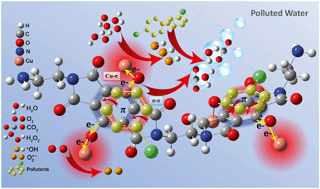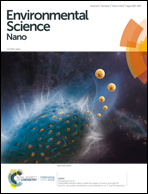Efficient Fenton-like process for organic pollutant degradation on Cu-doped mesoporous polyimide nanocomposites†
Abstract
Cu-Doped mesoporous polyimide nanocomposites (Cu-MP NCs) are developed via an in situ doping and hydrothermal polymerization method for the first time, which shows high activity and efficiency for refractory pollutant degradation, through a Fenton-like process in a very wide pH range (2.6–10.4). The reaction rate for pollutant removal is 15–21 times higher than that of the conventional Fenton catalyst. Based on the experimental and theoretical results, Cu+ and Cu2+ exist on the surface of Cu-MP NCs and bond with the aromatic rings of the polyimide substrate, through C–O–Cu bonding bridges, which induce cation–π interactions and result in the formation of electron-rich centers around Cu and an electron-deficient center on the bonding aromatic rings. During Fenton-like reactions, the π–π stacking between the aromatic rings of Cu-MP NCs and the aromatic rings of pollutants results in the adsorption and electron-donation of pollutants on the electron-deficient centers of Cu-MP NCs. This serves to inhibit H2O2 overoxidation and further accelerates the electron transfer cycles from the electron-deficient centers to the electron-rich centers through π → cation interaction via a C–O–Cu bridge and from the electron-rich centers to H2O2 with the generation of ˙OH.



 Please wait while we load your content...
Please wait while we load your content...